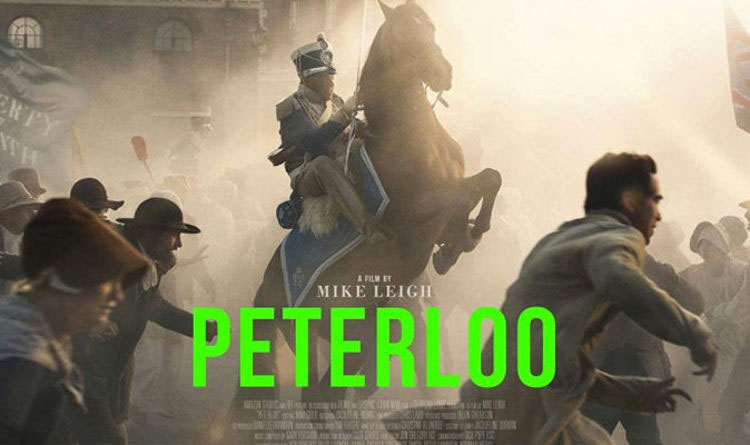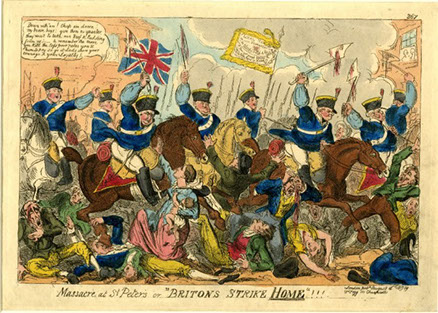

Peterloo (2018) The Film
200th Anniversary of the ‘Peterloo Massacre’
The film starts on the battle field: of Waterloo. A lone infantryman wanders around the bloody scene. The Duke of Wellington claims the glory and receives a handsome financial reward from Parliament.
In a state of shock, the young and bewildered foot soldier gets home to Manchester, clutching his bugle. He finds his family desperately poor faced with rising prices and hunger. In these opening scenes, we visually glean the context and gain a clue or two about the title.
Inventing Peterloo as a label for a dreadful event played with the name of the battle that brought an end in 1815 to the war with France A war that was started twenty two years previously in 1793. The term ‘Peterloo’ was coined by James Wroe, editor of the Manchester Observer, in the immediate aftermath of an inglorious battle that the nation’s armed forces engaged in against the ‘People’ in 1819. He paid a heavy price for his imaginative irony. Besides spending time in prison, his newspaper was closed down.
Peterloo, is a disaster movie with a difference. Arriving in the cinema, most of us had a shrewd idea as to what was going to happen to the Titanic - and why it was going to happen? We had a sound understanding of its context.
Not so, I suspect with the film Peterloo? For this, is a story that was dropped from the ‘national’ narrative within a generation or so of it happening. It’s a case of amnesia, consciously applied by the British educational establishment, to erase an embarrassment from popular memory.
Even those of us who studied history beyond school basics, have rarely been challenged in lecture hall or classroom, and certainly not asked in any examination paper, to take account of what happened at St. Peter’s Field, Manchester on 16th August 1819.
Yet, in the 1820s, and the immediate decades that followed ‘Peterloo’, any radical worth his or her salt, could give chapter and verse of that tragic day and would have known the name of John Frost’s hero, ‘Orator Hunt’ (who is played in the film by Rory Kinnear). Frost, like many others, named his second son after him.
Henry Hunt Frost was born 1 August in 1822, three years after the blood bath at Manchester that Frost knew and called the ‘Peterloo massacre’.

And this event, truly was the massacre that director Mike Leigh faithfully depicts. A vast crowd of working people took a mid summer holiday and walked miles from the mill towns and market towns of Lancashire to the great city, where Cotton was King. They arrived enthusiastically in support of petitions collected for the right to vote. Children, women and men crowded into St Peters ‘field’. Estimates of crowd size range from 60,000 to 80,000. They came, under orders, to carry nothing that might be construed a weapon. They sang, bands played, they moved with the music. Maxine Pike is there with the Female Parliamentary Reform Association. They were there to hear their local hero Sam Bamfield from Middleton speak alongside Hunt, the national figure - a man with his famous white hat and a superiority complex. As Leigh shows very pointedly in the film, radical politics (like Chartism later) had its ‘pecking order’ and Hunt considered his place was top of the tree.
Women had importance in the movement, but it was a ‘place’ determined by domestic demands. Although many radical leaders valued their vital moral and educational influence, women were expected to marry young, breed and rear a family and be the support worker for their men folk. This was a society where life for many was short, sharp and brutal. Searching rural or urban parish records in this period reveals devastating numbers of infant deaths - and mothers.
See the film and you will understand why the Chartists came armed with pikes, guns and their mandrels to Newport in November 1839. They carried these they insisted, in self defence. It was a response to the violent action taken on 10 May at Newport that year by the special constables against unarmed protesters, who were attempting to free Henry Vincent and three Newport Chartists. Such action by the authorities in Newport was recognised by the protesting crowd as a reflection/repetition of ‘Peterloo’ twenty years before.
Twenty years earlier, backed by regular infantry and under orders from a panicking magistracy, the meeting at St. Peter’s Field was savagely broken up by a drunken local militia, comprising sons of local gentry, riding in with sabres flaying; their horses trampling hundreds, killing perhaps 18 people, including a woman and a child, and maiming more than five hundred.
Before the day was over, the government instructed the police and courts to raid the Manchester Observer, mouthpiece of the Patriotic Union Society. Cases against its staff were rushed through. Found guilty of producing a seditious publication, Wroe was sentenced to 12 months in prison and fined £100. The magistrates closed the newspaper in February 1820.
Eight men were brought before the York Assizes on 16 March 1820, charged with sedition. Three of them were Wroe’s colleagues - Johnson and Healey sentenced to 12 months imprisonment, with Knight receiving two years. Hunt, the middle class leader, served 30 months in Ilchester gaol and Bamford the weaver spent 12 months in Lincoln gaol.
Eventually a civil case on behalf of a wounded weaver was brought on 4 April 1822 against four members of the Manchester Yeomanry. All were acquitted and the court ruled their actions were justified because they were dispersing an illegal gathering.
In the immediate aftermath of ‘Peterloo’, it seemed to the authorities that the country was heading towards armed rebellion. This was a fear confirmed that winter by the discovery and foiling of the Cato Street conspiracy to blow up the cabinet.
In the depths of economic depression and food shortages 1816-19, faith had been invested in the possibility of constitutional reform through the lobbying and petitioning of Parliament. ‘Peterloo’ dashed such hopes. Lord Liverpool’s Tory government exonerated the perpetrators, rejected reform and increased its crackdown on radical publications, meetings and speeches by passing Six Acts, known popularly as the ‘Gag’ Acts. These also banned unlawful drilling, gave magistrates powers to search for weapons and to refuse bail, and increased the stamp duties on publications.
And for the next three decades, radicals who campaigned for representative government wrestled with the problem of how to convince an unrepresentative, ‘corrupt’ Parliament to reform itself.
Influenced by Thomas Paine Rights of Man (1792), they were in no doubt that Tyranny should be resisted and that this meant breaking unjust laws. Debate revolved around the morality and the effectiveness of different forms of direct action. Deliberate harm to persons was not supported, damage to property was not advocated, but mass action was bound to disturb the peace and cause ‘commotion’. What exactly was meant by the Chartist conundrum ‘peacefully if we may, forcibly if we must’? O’Connell’s ‘Physical force’ tactics gained Catholic emancipation in 1829. Riots and disturbance played a significant part in changing hearts and minds during the 1831-32 Reform campaign and the passing of the ‘Great’ Reform Act, as did mass action 1834-36 concerning the Tolpuddle martyrs. ‘Such success meant that Physical force’ methods were gaining ground in radical circles.
Percy Bysshe Shelley received the news of ‘Peterloo’ in Italy that September.
His inspired reaction to ‘Peterloo’ was to write The Mask of Anarchy - a poetic political polemic of 91 stanza against a tyrannical Government .
I met Murder on the way -
He had a mask like Castlereagh -
Very smooth he looked, yet grim;
Seven blood-hounds followed him:
It was sent back to Britain, to his friend Leigh Hunt, who felt it could not be safely published in the toxic atmosphere post-Peterloo.
It remained unpublished until 1832 when The Masque of Anarchy saw the light of day. Shelly was dead. He had died (in a drowning accident) 10 years earlier in July 1822 at Lerici, Italy.
The poem was released by people who feared the rise of ‘physical force’ and saw Shelley’s poem as a strong appeal for non-violent resistance, he was advocating mass moral action. His new found ‘acolytes’ wanted radicalism to keep the high ground.
Stand ye calm and resolute,
Like a forest close and mute,
With folded arms and looks which are
Weapons of unvanquished war.
And if then the tyrants dare,
Let them ride among you there;
Slash, and stab, and maim and hew;
What they like, that let them do.
With folded arms and steady eyes,
And little fear, and less surprise,
Look upon them as they slay,
Till their rage has died away:
Then they will return with shame,
To the place from which they came,
And the blood thus shed will speak
In hot blushes on their cheek:
Rise, like lions after slumber
In unvanquishable number!
Shake your chains to earth like dew
Which in sleep had fallen on you:
Ye are many—they are few
It climaxes
Men of England, heirs of Glory,
Heroes of unwritten story,
Nurslings of one mighty Mother,
Hopes of her, and one another!
What is Freedom? Ye can tell
That which Slavery is too well,
For its very name has grown
To an echo of your own
Let a vast assembly be,
And with great solemnity
Declare with measured words, that ye
Are, as God has made ye, free.
The old laws of England—they
Whose reverend heads with age are grey,
Children of a wiser day;
And whose solemn voice must be
Thine own echo—Liberty!
Rise, like lions after slumber
In unvanquishable number!
Shake your chains to earth, like dew
Which in sleep had fallen on you:
Ye are many—they are few!
Dr. Katrina Navickas will introduce Mike Leigh’s Peterloo film at the Riverfront, Newport on Thursday 31 October 2019.
She will be speaking on Saturday 2 November to the 13th Newport Chartist Convention at the Cathedral (St. Woolos).
Katrina, a senior history lecturer at the University of Hertfordshire, is a long-standing friend of the Newport Chartist Convention and we look forward to her return for the Newport Rising Festival weekend. 1st - 4th Nov 2019
Les James Oct 2019









